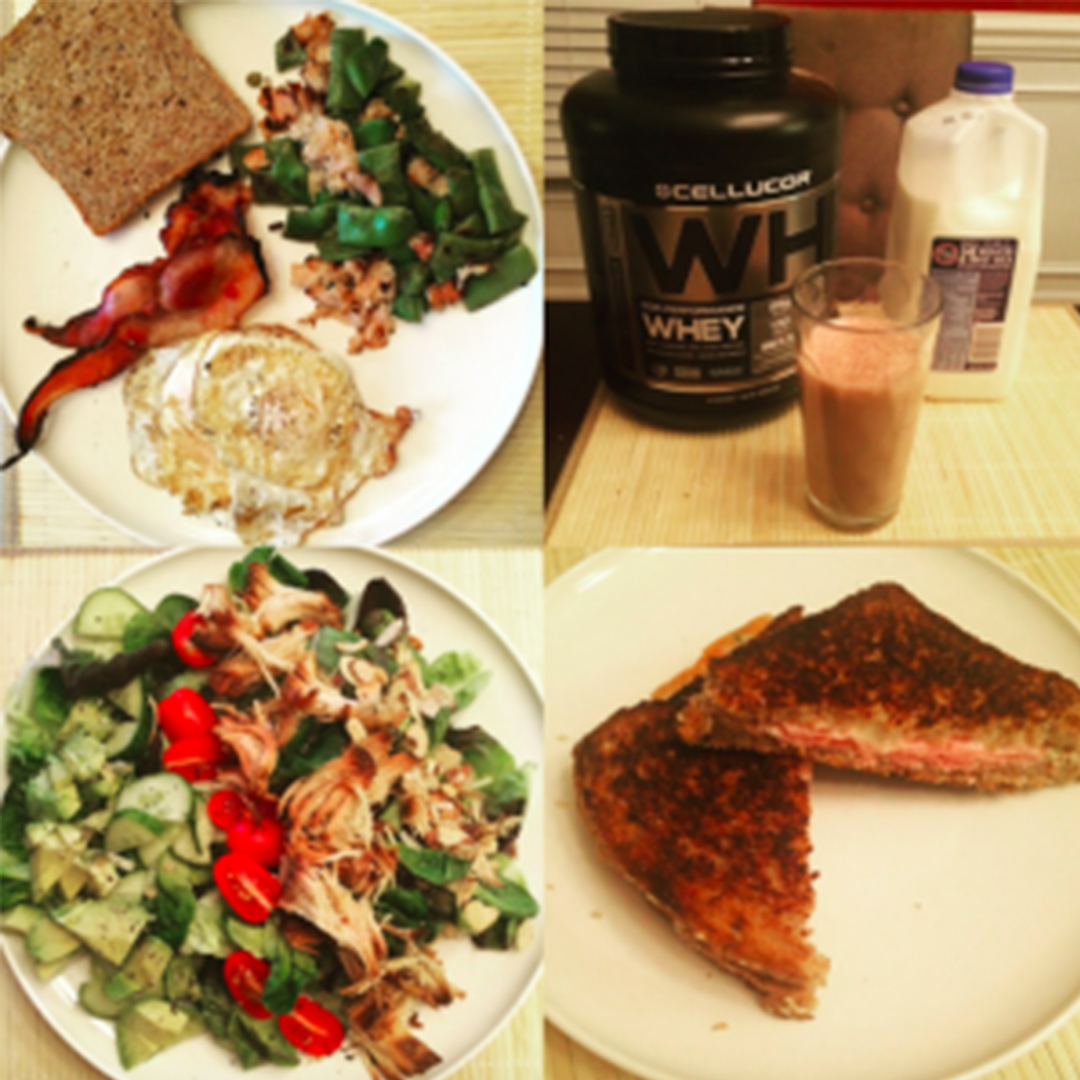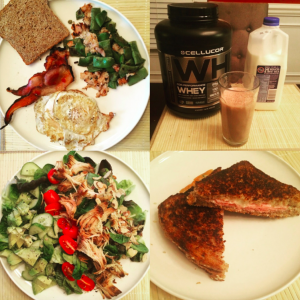Stricter is Not Better:

In 2006, I stumbled across a popular fitness blog that was promoting a new kind of diet challenge. The blogger invited any and all of his readers to join in on adhering to the 20 nutrition rules he’d made for himself. The purpose, he wrote, was to crack down on his eating behaviors and become the pinnacle of nutrition perfection. Anytime you broke one of the rules, you would add a point to your running total. By the end of the challenge, the individual with the fewest number of points was the winner.
Drink a gallon of water, eat six meals, and consume three servings of vegetables a day. No more than X number of calories per meal. Don’t go longer than 3 waking hours between meals. Eat half a grapefruit within 30 minutes of waking up. No added sugars. No artificial sweeteners. No trans fats.
Wow! I remember reading the list with astonishment. I was so impressed at how strict he was going to be with himself, and I excitedly shot an email to my dad that same night urging him to hop in on the challenge with me. Instead of 20 rules, however, I somehow came up with a whopping 100 rules that I was to adhere to every day — because the stricter I was, the better I’d do, right?
Looking back, I almost feel that I should slow clap for having the creativity to have come up with so many nutrition rules. Or perhaps I should be groaning in embarrassment that these were the kinds of things that occupied my free time at the age of 16.
In any case, my dad politely declined the challenge (much to my surprise at the time), and I forged ahead on my own – for a heroic three days. It didn’t take long for me to realize that 100 freakin’ rules was way too many for me to keep track of, and I quickly grew tired of my rapidly accruing points. Argh!
What had I done wrong?
I mistakenly believed for many years that eating perfectly and getting lean was all about being really, really strict on myself. Anytime I slipped up and ate the chocolate chip cookie I swore I’d never touch, I’d find myself clearing off the entire plate in a panic, then berating myself for obviously not trying hard enough. I’d vow to do better and never let this mistake happen again – but only after I’d inhaled the box of sugary cereal, too. Oh, and the ice cream.
That strategy never worked. And yet, I continued to stubbornly persist (unsuccessfully so) for years. It never crossed my mind that anything other than a black-and-white approach would elicit the results that I so desperately wanted.
As it turns out, however, rigid dieting is not a realistic long-term strategy, and it’s far from the most effective way to get and stay lean year-round.
Rigid vs. Flexible Eating
Westenhoefer (1991) defines rigid eating as adopting an “all or nothing” approach to eating, dieting, and bodyweight. Some examples of this include deeming some foods “good” and others “bad,” having a forbidden foods list (or conversely, a very short approved foods list), thinking of yourself as a failure if you exceed a given bodyweight, and crash dieting, starving, and binge eating.

On the other hand, flexible eating entails a far more “graduated” mentality towards eating, dieting, and bodyweight. Rather than characterizing foods as good or bad, there are foods that should be consumed more frequently and those that should be consumed less frequently.
A 2002 study by Stewart, Williamson, and White titled, “Rigid vs. flexible dieting: association with eating disorder symptoms in nonobese women,” compared the differences in eating disorder symptoms, mood disturbances, and body mass index (BMI) between rigid and flexible dieters.
One hundred and eighty-eight female undergraduate students and community members were recruited for this study. The researchers assessed the following via questionnaires: degree of rigid vs. flexible control of eating, BMI, depression, eating attitudes (to measure eating disorder symptoms), body dissatisfaction, anxiety, and dietary restraint, disinhibition, and perceived hunger.
Analysis of results revealed that those who engaged in rigid eating strategies had higher BMI, higher anxiety, and experienced greater mood disturbances and eating disorder symptoms, including binge eating. Interestingly, the majority of participants were found to employ a mix of both rigid and flexible dieting strategies.
This explains a lot, doesn’t it?
Granted, the study by Stewart and colleagues (2002) was cross-sectional, meaning that we can’t establish a causal relationship between flexible eating and lower BMI. However:
- Rigid control of eating behaviors in men and women is associated with more eating disorder symptoms and greater mood disturbances than was flexible control of eating behaviors (Timkho and Perone, 2005).
- A monotonous diet (such as one with little variety due to elimination of “forbidden” foods) triggers food cravings (Pelchat and Schaeffer, 2000), which has found to be associated with higher BMI and binge eating behaviors (Abilés et al., 2010; Moreno, Warren, Rodríguez, Fernández, & Cepeda-Benito, 2009).
- Rigid dieting control strategies have been found to be inversely correlated with dieting success, while flexible dieting control strategies has been found to be positively correlated with dieting success (Meule, Westenhöfer, and Kübler, 2011).
What does this all mean?
Rigid eating is not an effective strategy for long-term weight loss maintenance.
Though the research on this topic is not abundant, the evidence that does exist is pretty difficult to refute. On an anecdotal level, I can tell numerous stories of my clients (and myself) who have reported great success, both with their mindsets and with their body fat levels, by making the transition from black-and-white thinking with their eating to a more moderate, flexible eating approach.
For me personally, I struggled with binge eating for 10+ years. It wasn’t until I finally let go of my stringent dieting rules (that never, ever worked – go figure) and forced myself to get comfortable with moderation that my eating behaviors started to normalize.
- I now eat cookies, ice cream, and chips every now and then, and I enjoy every scrumptious bite.
- I’ve been maintaining a healthy bodyweight within a 5lb range for the past two and a half years with ease.
- I haven’t binged a single time since then.
You may think that the above points are paradoxical, but actually, they are absolutely, absolutely related. And it’s precisely this more lax approach with my eating that has contributed to my success.
How to Approach Flexible Eating
Flexible eating, of course, is not license to eat whatever. It’s not akin to ad libitum food consumption, as most people tend to think.
The very word “flexible” implies that there is still some degree of structure to your eating. Namely, here’s what should form the backbone of your diet:
- Approximately 1g protein per 1lb bodyweight per day
- Majority of calories coming from nutrient-dense foods
- Carbs and fats tailored to suit your personal preferences while providing sufficient energy
As well, there should be no feelings of guilt associated with food consumption, including the more nutrient-devoid treats. Calorie intake should never get out of hand – neither too high nor too low – and portion control should be exercised at all times.
And the rest of the details? Well, that’s for you as the individual to decide.

(See related: Flexible Dieting Myths and This is What Flexible Dieting Actually Looks Like)
I would be remiss not to include the caveat that there does happen to be a handful of people who genuinely enjoy eating nutrient-dense foods 24/7 and find no pleasure in chips or sweets (I, sadly, am not one of them). For these individuals, the lack of junk food in their diets is due to the fact that they don’t care for them, not that they are forbidden themselves from consuming the treats. In their case, they are still practicing flexible eating strategies because they are not “violating” any of their own food rules.
If you’ve found that many of the nutrition rules you’ve implemented for yourself haven’t been working so well, I urge you to loosen the reins on your eating.
Find a nutrition strategy that you enjoy and can adhere to long-term.
Nip cravings in the bud before they spiral out of control.
Enjoy your food guilt-free.
Become a master of nutrition moderation.
Maintain your weight loss results for good.

References
Abilés, V., Rodríguez-Ruiz, S., Abilés, J., Mellado, C., García, A., de la Cruz, A. P., & Fernández-Santaella, M. C. (2010). Psychological characteristics of morbidly obese candidates for bariatric surgery. Obesity Surgery, 20(2), 161-167.
Meule, A., Westenhöfer, J., & Kübler, A. (2011). Food cravings mediate the relationship between rigid, but not flexible control of eating behavior and dieting success. Appetite, 57(3), 582-584.
Moreno, S., Warren, C. S., Rodríguez, S., Fernández, M. C., & Cepeda-Benito, A. (2009). Food cravings discriminate between anorexia and bulimia nervosa. Implications for “success” versus “failure” in dietary restriction. Appetite, 52(3), 588-594.
Pelchat, M. L., & Schaefer, S. (2000). Dietary monotony and food cravings in young and elderly adults. Physiology & behavior, 68(3), 353-359.
Stewart, T. M., Williamson, D. A., & White, M. A. (2002). Rigid vs. flexible dieting: association with eating disorder symptoms in nonobese women. Appetite, 38(1), 39-44.
Timko, C. A., & Perone, J. (2005). Rigid and flexible control of eating behavior in a college population. Eating behaviors, 6(2), 119-125
Westenhoefer, J. (1991). Dietary restraint and disinhibition: is restraint a homogeneous construct?. Appetite, 16(1), 45-55.




